The search for the top players in a league is a constant area of interest for players, coaches, and football fans alike. However, the interpretation of the “best” or “top” players is a discussion which almost will always end in disagreement. Therefore, within this data analysis of the top MLS homegrown players, it is important to set some ground rules. The first is to clarify the inclusion criteria. Unless otherwise described players needed to have signed an MLS homegrown contract and played at least 10 total MLS matches prior to the nationwide lockdown to be considered in this top XI for a position. In order to incorporate all positions the formation of this hypothetical homegrown XI is a 4-3-3 utilising two central midfielders and one attacking midfielder, as well as two wide wingers and one central forward.
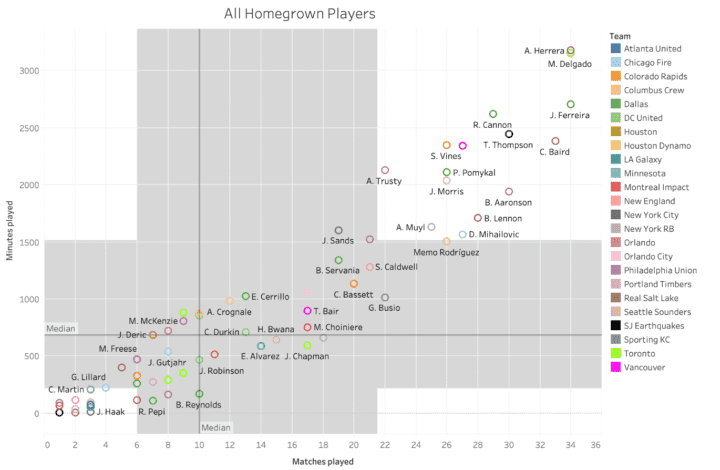
That being understood the picture above shows the median minutes and matches played between all listed MLS homegrown players. The median for these metrics were 672 minutes played and 10 matches played. With these values accounted for it allows the analysis to start taking shape and provides criteria to exclude the players with less total experience. Next is to separate players via position and investigate the statistics which contribute most to success in the various positions. It is also important to note that more than just the statistics used in the graphics for this article were investigated. Some that showed insignificant differences were excluded to allow for other metrics to be analysed and included between the groups of players.
Goalkeepers
Goalkeepers were perhaps the easiest to investigate and determine within the entire group of homegrown players. Largely, due to the fact that only two homegrown contracted players are currently in the MLS. Those two goalkeepers are 31-year-old John Tyler Deric of the Houston Dynamo and 21-year-old Matt Freese of the Philadelphia Union.
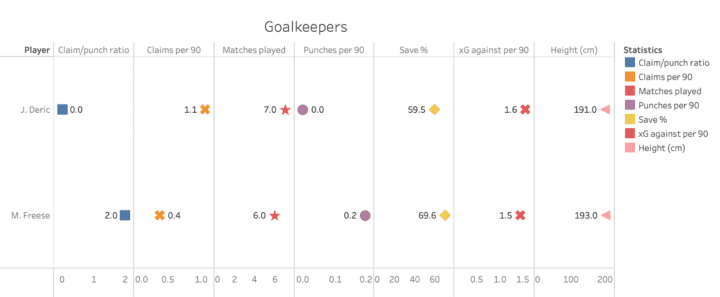
When comparing these two keepers a couple of statistics jump out immediately. The first is their save percentages which Freese edges out ahead of Deric with almost 70%. The next is claim/punch which again shows Freese ahead of Deric, although Deric is ahead of Freese in total claims per 90 at 1.1. They’ve also played a similar number of matches, are similar in size, and both have an expected goals against of over 1 which isn’t the greatest statistic for a goalkeeper. However, when you take into account Freese is 10 years younger than Deric the logical decision would be to go with a younger keeper expecting him to improve as he plays in more matches. Therefore, Freese takes the number 1 spot in this comparison and becomes the goalkeeper for this MLS homegrown XI.
Defenders
When analysing defenders statistically, it can be a difficult task. A player’s quality may not always be perfectly seen through football statistics as so much can be influenced by a style of play or coaching philosophy. Still, there are a few specific stats which do make it easier to understand the quality of defenders regardless of these facts. These metrics are useful in helping coaches and fans decipher what makes a quality outside or centre back. Defensive stats such as, a player’s ability to tackle, win defensive duels, win aerial duels, and intercept passes are all stats which give us some indication of their overall defending ability or effectiveness. From an attacking standpoint, it can be a bit less straightforward. Certainly passing ability, winning offensive duels, dribbling, and getting involved in attacking situations are critical to playing outside back in the modern game. From there we can take a look at the statistics below and start to understand which players have performed well enough to separate themselves from the rest of the group.
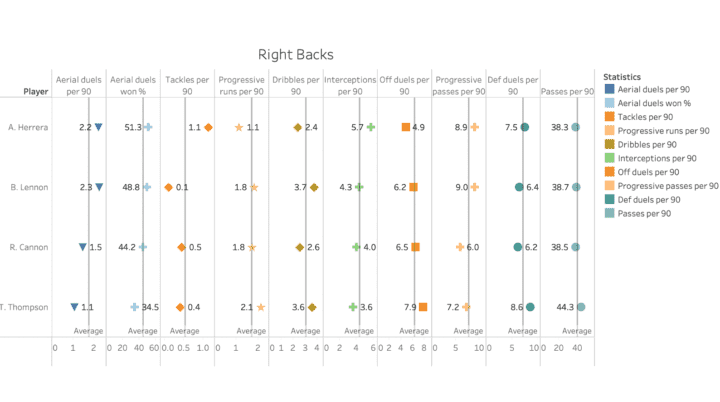
In the above analysis, we see the top 4 right backs based on the set criteria for homegrown right-backs in the MLS. Perhaps the most notable name is 22-year-old Reggie Cannon of FC Dallas who has attracted the interest from clubs in the EPL. Interestingly, though he does not come out on top when compared to the rest of this group.
Through this analysis, we see Brooks Lennon of Atlanta United has the most stats above the average in this group. Highlighted in particular by his aerial duels, dribbles, interceptions, and progressive passes all areas he comes either first or second. His ability on the dribble with the high number of progressive passes and runs is vital for an outside back to get involved in the attack. Winning aerial duels and his high number of interceptions per 90 is also impressive and displays he had quality in defensive situations as well.
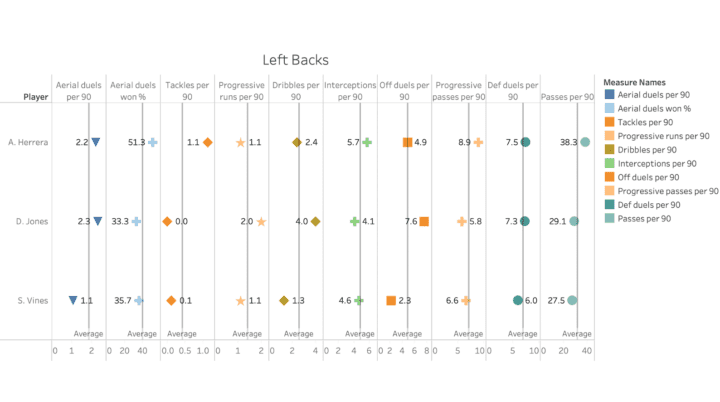
As for the outside backs, the same statistics were utilised. However, for left-backs, it is a much shorter list. Still, Aaron Herrera of Real Salt Lake is the player who proves to be the best statistically in this group. Here, Herrera comes first in six of the ten statistics analysed. For him most notably are the number of tackles, interceptions, progressive passes, defensive duels, and passes per match in which he is at the top of the list. These stats indicate he doesn’t run forward as often as Lennon but certainly looks to provide the pass to get his team into attacking situations. Ultimately, taking all of these stats into consideration it shows the overall ability of both outside backs offensively and defensively, a necessary combination for the modern-day outside back.
Moving on to the centre backs. As expected there are notably typically fewer circumstances which warrant forward runs or attacking types of situations for centre backs. Therefore, placing more significance on their ability to defend while it is still important for them to possess the quality on the ball in keeping possession or looking to start a counter-attack.
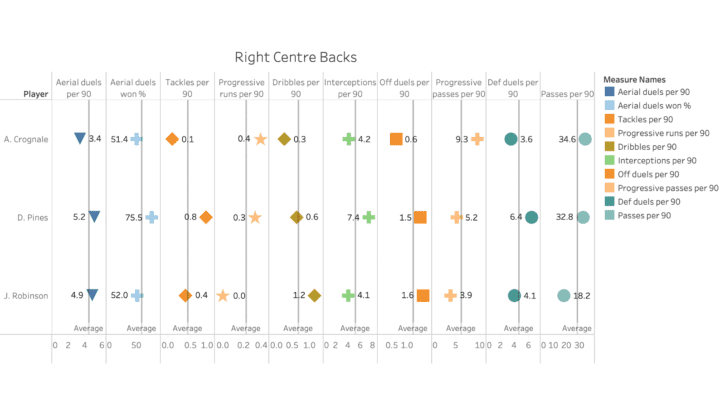
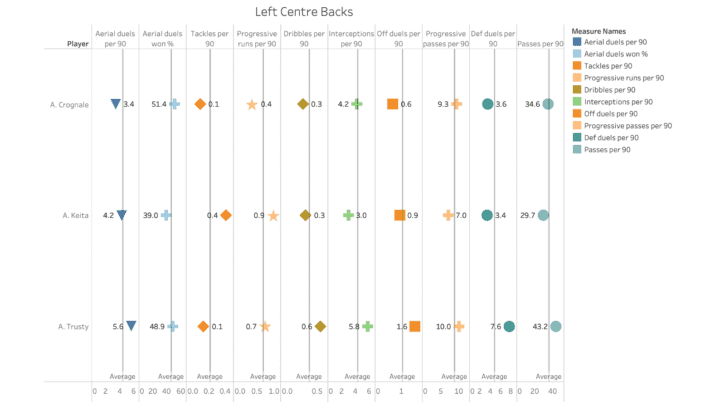
With only three options for each centre back role, it makes it a bit easier to decipher who is at the top for each group. Due to the fact it’s not uncommon for centre backs to play either role Alex Crognale of the Columbus Crew shows up in both lists. However, his stats were not good enough to place him at the top in either. For the right centre back role 22-year-old Donovan Pines of DC United showed to be the best statistically, and for the left centre back it’s 21-year-old Auston Trusty of the Colorado Rapids. Both players showed their defensive quality leading their groups in aerial duels, interceptions, and defensive duels per 90 minutes. Similarly, both show their quality on the ball coming either first or second in progressive passes and total passes per 90.
Therefore, taking all of these stats into consideration we see the overall quality of these four defenders both offensively and defensively. While they are young which is to be expected of homegrown players being at the top of their groups in both areas is what makes them well-rounded footballers, creating what would be a hypothetical “good footballing backline.”
Midfielders
For the purpose of this analysis, the central midfielders have been split between two groups. The first group is more relevant to holding and box-to-box central midfielders. And the second being more attacking minded and in the build of a classic 10.
Still, what does a quality defensive midfielder look like, and what characteristics does this player need to be successful. Certainly, in the modern game, the ability to defend and intercept passes is vital. A willingness and capability to get on the ball in possession with a strong passing range is also a necessity. Lastly, perhaps the difference maker in this position are central midfielders who can consistently look to play forward and find teammates in attacking positions.
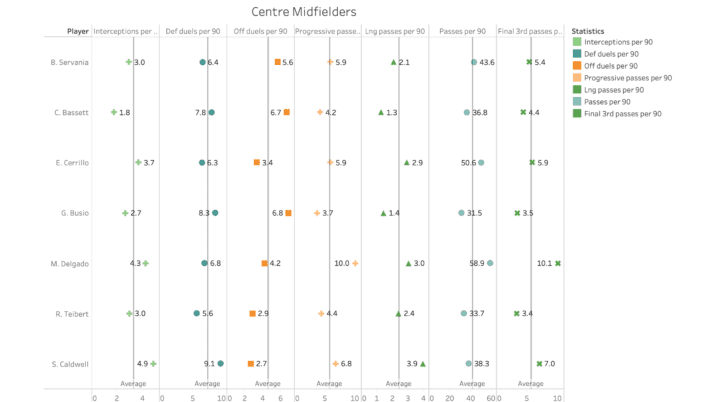
While this analysis is a bit trickier due to the larger group of players the top of the group is quite clear. Coming in at the top perhaps surprisingly is 24-year-old Marky Delgado, a former Chivas USA homegrown player. When looking at his stats they are quite impressive. Defensively, we can see his ability through his interceptions, and duels per 90 minutes. On the attacking side, we see his remarkable passing ability. Averaging 10 progressive passes, nearly 60 total passes, and just over 10 final third passes per 90 minutes it’s clear he looks to find teammates in dangerous attacking positions.
Coming in at a close second is 20-year-old Edwin Cerrillo of FC Dallas. Similar to Delgado, Cerrillo’s quality defensively is displayed through his interceptions and duels per 90 minutes which put him in the top half of this group. However, his passing ability is what separates him from the rest of the group. Averaging nearly 6 progressive passes, 3 long passes, 50 total passes, and 6 final third passes per 90 minutes put him just below Delgado.
Surprisingly, we see 17-year-old wonder boy Gianluca Busio who’s drawn attention from Fiorentina of the Serie A is not at the top of this group. His total number of duels is higher than both Delgado and Cerrillo however, both show better passing statistics in each of the 4 categories. Still, he’s a player on the rise and certainly could make the case to be the first man off the bench if this analysis were including more than the top XI players.
Onto the exciting attacking midfielders. Perhaps, the biggest difference from number one to number two comes in this position analysis.
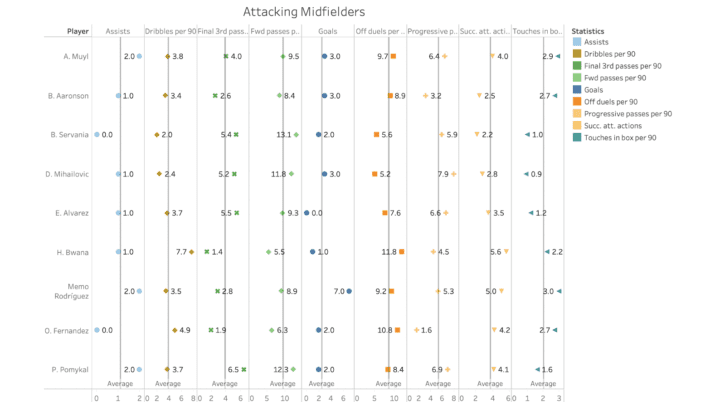
As seen in the above image several players show well in this group. Included in the honourable mention should be Paxton Pomykal of FC Dallas and Djordje Mihailovic of the Chicago Fire.
Both with impressive stats for forward passes and progressive passes per 90 minutes. Still, it is 24-year-old Memo Rodriguez of the Houston Dynamo that rose to the top in this group. With two assists and seven goals he vastly surpasses the rest of the group in total points. While above average in most categories his offensive duels and touches in the box combined with his total points are what put him at number one. At the age of 24 Memo has shown his quality in producing goals and assists for Houston and is certainly a young developing talent to keep an eye on for the future.
Centre forward and wingers
The analysis for the centre forwards was the most unique of this entire analysis. The reason for that being only one homegrown centre forward has played over 10 MLS matches. Due to that fact, the parameters for this position were changed to include any player who had over 6 matches played. Even with this change it still only produced four centre forwards to compare and analyse.
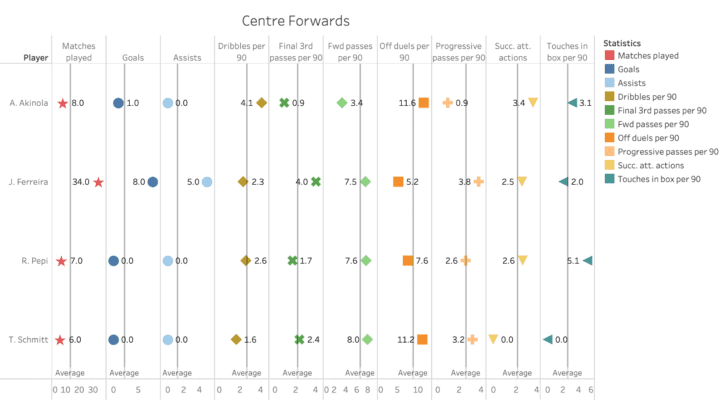
Luckily, as seen from the image above the decision on who is the best was not tough to conclude. Jesús Ferreira the 19-year-old FC Dallas man is without a shadow of a doubt the best homegrown centre forward in the league. With eight goals and five assists, his point total is significantly higher than the others in this group and he was regularly selected by his side during the 2019 season. That combined with his final third passes, progressive passes, and touches in the box certainly put him at number one in this group at least for now. Interestingly, 20-year-old Ayo Akinola of FC Toronto also has statistics which show some promise. While his passing stats are on the low side for this group he makes up for it leading them in dribbles, offensive duels, and successful attacking actions per 90 minutes. Perhaps, indicating with a bit more match experience he could become an important player for Toronto FC who could be losing star centre forward Jozy Altidore in the near future.
To round out this top XI is the analysis of the wingers. Interestingly, both of the top wingers come from the reigning MLS champion Seattle Sounders. Therefore this final section of the analysis will look at both players and positions.
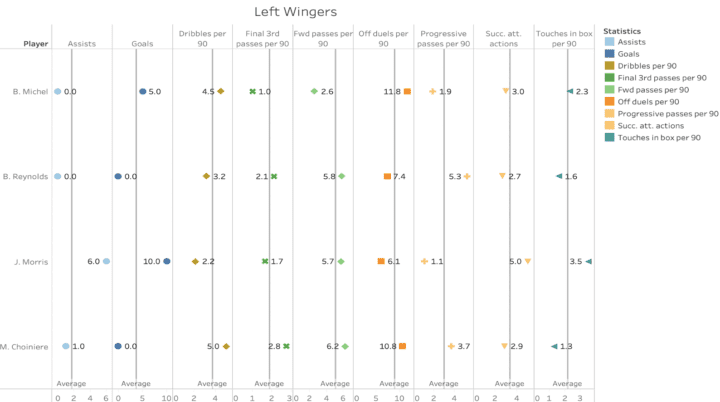
For the left-wingers, Jordan Morris of the Sounders is well ahead in overall production. With 10 goals and 6 assists in just 26 matches. His numbers also show his lethality around the goal as even though he isn’t at the top of this group for all the stats, he still is well ahead in total points.
Similarly, his touches in the box per 90 are well above the rest of this group showing he gets into dangerous areas regularly during a match. Not bad for a 24-year-old homegrown player that initially turned down Bundesliga interest before signing the highest homegrown contract ever at the time in 2016.
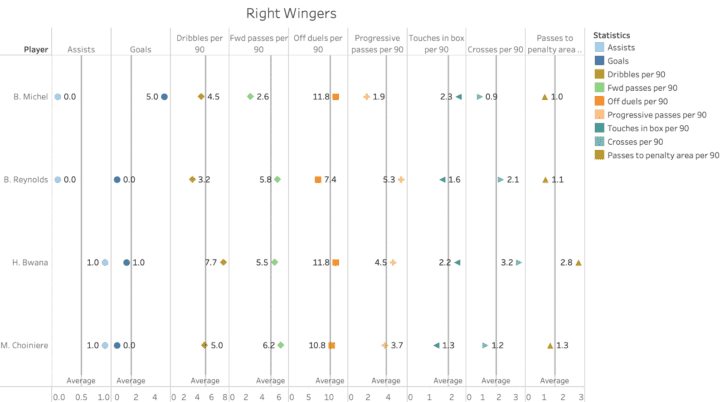
As for the right-sided wingers, it is a closer race. Here we see two 22-year-olds at the top of the group, Handwalla Bwana of Seattle and Benji Michel of Orlando City. The most notable difference between these two players is the difference in goals scored. However, Michel has nearly double the minutes played as Bwana. Therefore, when looking at the remainder of the stats more of the story is told. Bwana’s ability on the ball is clear when noting his dribbles, progressive passes, crosses, and passes to the penalty area per 90. All four of those stats he comes in at first. Combined with his 1 goal and 1 assist it seems fair to say with more match experience he has the quality to increase his production. As a result, he is the top player in this group and rounds out the final player for this top XI.
Conclusion
Ultimately, the goal of this data analysis was to find the best homegrown players in each position. While this could easily be debated between players, this analysis aimed to investigate stats which create well-rounded footballers. Looking at both attacking and defensive abilities and weighting them accordingly for each position. Therefore, based on the data available the picture below shows this lineup for total footballers, creating the top XI homegrown Major League Soccer players by position.
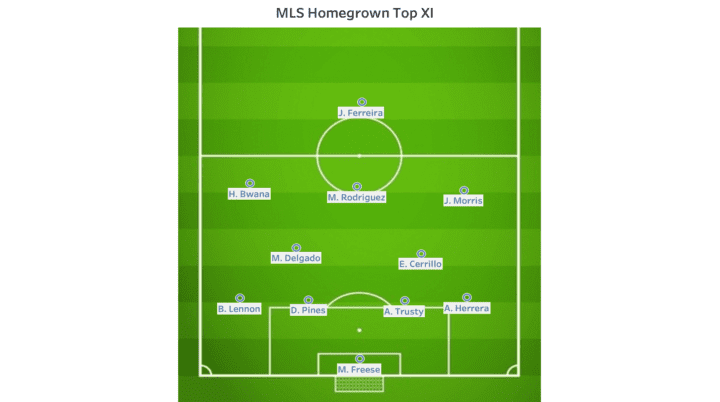

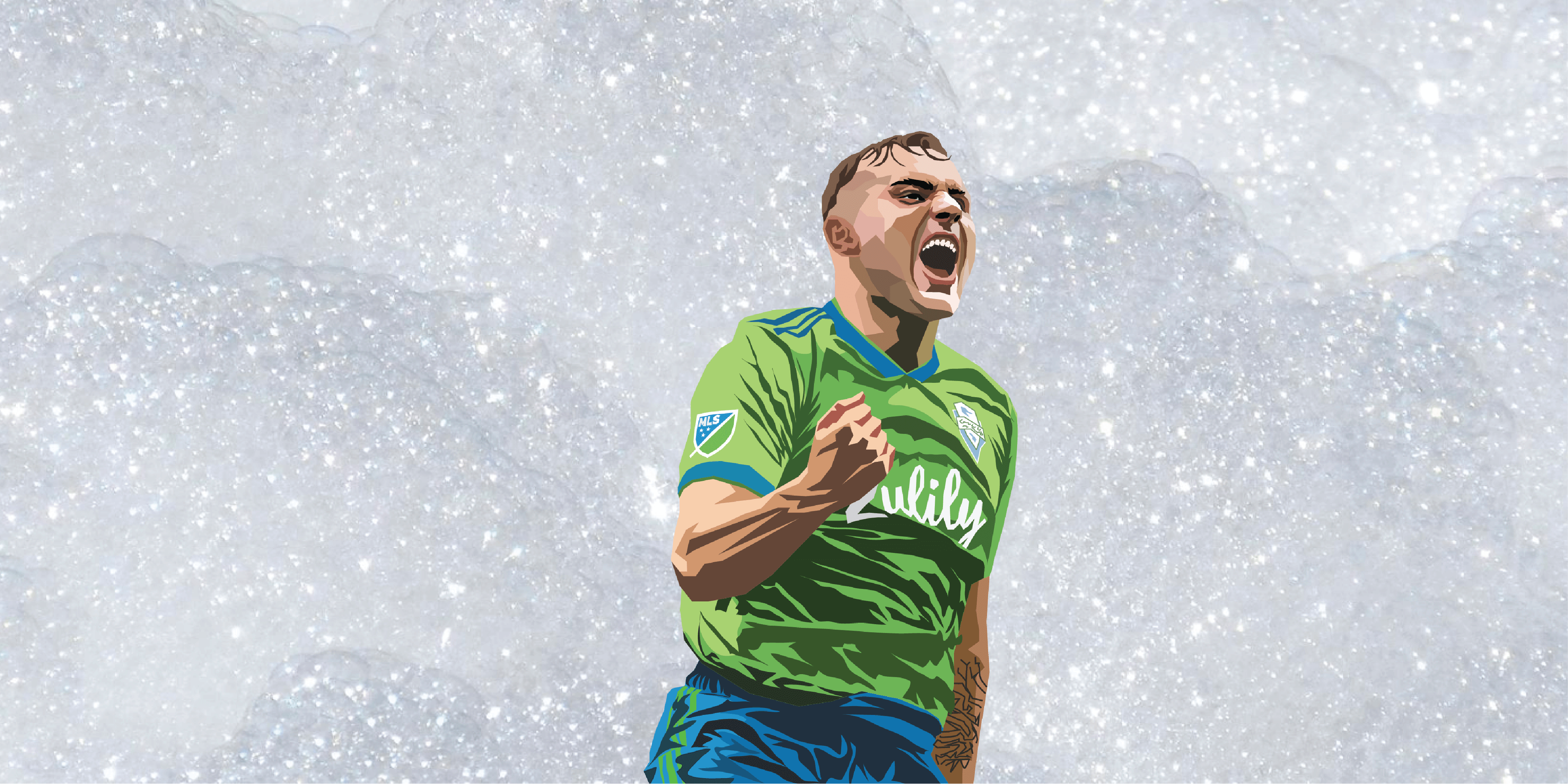




Comments